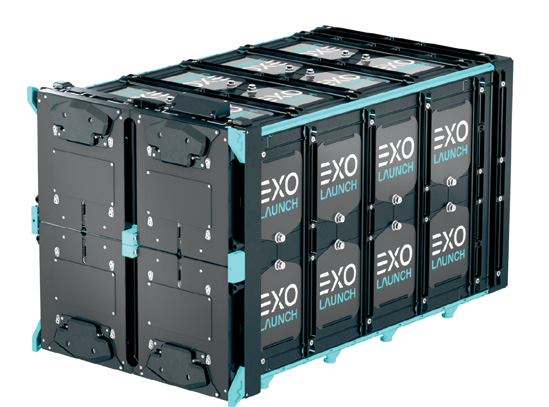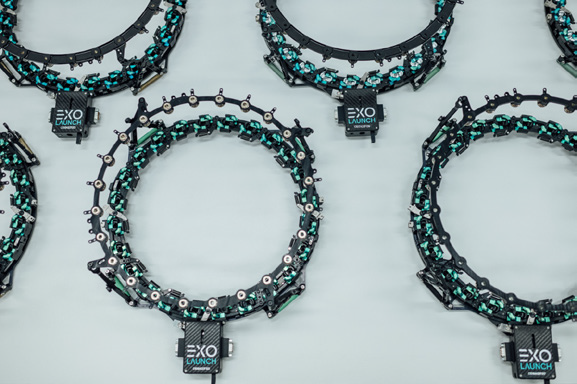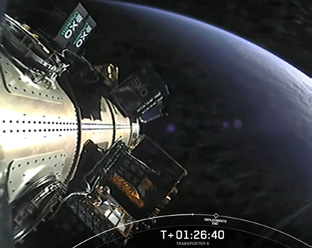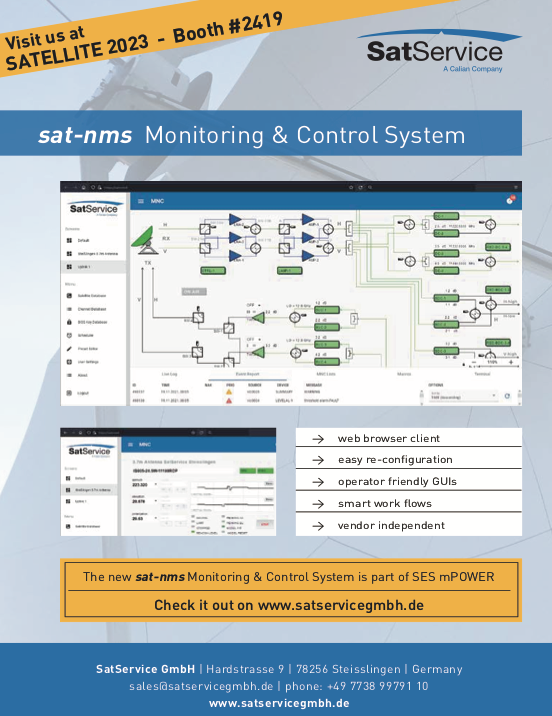Kier Fortier is the Managing Director at Exolaunch USA, where he leads U.S. business development. He has been involved in the integration and launch of more than 150 multinational small satellites on six different launch vehicles. Kier has extensive experience in the New Space industry and has held positions with Spire Global and the Laboratory for Atmospheric and Space Physics. Kier holds a B.S. and M.S. in Aerospace Engineering Sciences from the University of Colorado Boulder.
Mr. Fortier. Please tell our readers how Exolaunch came into being?

Kier Fortier
Kier Fortier
Exolaunch was born in 2011 as an offshoot of T.U. Berlin with a goal to offer students the opportunity to send their projects into space. Since then, ensuring the ability for everyone to reach space has been the company’s cornerstone value.
We don’t wish to reinvent the wheel. On the one hand, we use proven technology with ingenious, robust hardware for maximum reliability. On the other hand, we offer responsive, customer-driven integration, mission management and testing services that innovators can depend upon — in fact, these serve as a gateway to many new market entrants that are either operating or building their satellites for the first time.
New Space is all about democratizing access to orbit and at Exolaunch we have worked hard to make that a reality. We spent a decade building an impressive launch record — more than 265 satellites across 18 missions, as of this writing. This makes Exolaunch ideally placed to catch the step change provided by SpaceX’s Transporter program, which has been instrumental in providing regular and reliable access to space. Exolaunch has been a part of every Transporter mission to date, and we have launched more than 150 satellites on Falcon 9 alone, with even more launches scheduled for this year!
How do you get customers ready for launch?
Kier Fortier
From day one, we guide our customers through the process of preparing their satellites, coordinating the logistics of the mission and planning all of the test and requirement verifications. For most of our missions, we have dozens of satellites coming from multiple countries and continents. The mission comes together when we integrate the satellites with their separation systems, and then with the launch vehicles themselves.
As we work with a wide range of satellites (cubesats up to 16U and microsatellites up to 500 kg.), we follow stringent and detailed preparation procedures to ensure our customers’ satellites are ready to fly. We host the integration process for cubesats in our Berlin, Germany, facilities where our mission management team works with the customer technical staff. It’s always a pleasure to have the chance to work in person with customers and have them join us in sharing this moment, seeing the doors of the deployer close behind the cubesat, knowing that the next time those doors open, the smallsats will be in space. We also perform launch-site integrations for our smallsat customers after autonomous satellite checks have been completed.

Heritage is everything in the space industry: it’s a token of a firm’s reliability and success. That’s why our lodestar is to help customers build their own expertise by turning a satellite into a “separation confirmed” and “contact established” moment. Working within the New Space environs means our customers are constantly innovating and deriving fresh ideas — we are always challenged to find new solutions to unexpected challenges, meet them where they are and take them to that on-orbit finish line.
All of our hardware in the EXOpod and CarboNIX deployer lines are highly user friendly and they are fully compatible with many of the existing launch vehicles on the market today. Testing is especially painless as it takes very little time to reset our deployers and separation systems, whether in the clean room — or during those important quick checks at the launch site. We wouldn’t be able to have this level of flexibility if we didn’t design and manufacture our separation systems in-house from the ground up. This built-in familiarity we have with our hardware means every mission manager can react quickly to both ends of our services, whether troubleshooting with the launch provider or answering customers’ questions on the CAD or systems design. It’s a testament to the level of customer service and technical ability we provide that 95% of our customers return for our services.
Exolaunch had a busy launch schedule during 2022 — what’s on tap for 2023?
Kier Fortier
Yes, we’ve been quite busy. In 2022, we introduced a new line of deployment systems and executed four missions that included three Transporter missions with SpaceX and one with Rocket Lab. The pace of our launch schedule has really picked up speed in recent years thanks to the Transporter missions and we’re delighted to have been able to cultivate a good relationship with SpaceX through these operations. We had already had the chance to work with SpaceX on the first two Starlink missions with rideshare payloads when they started their dedicated rideshare program, so we had experience with the Falcon 9 and were ready to bring in long-term customers and proven separation systems. The program came at an opportune time to fill a gap in reliable, affordable and regular launches, and we have manifested increasingly complex and diverse payloads on every Transporter launch since the first one

This year, we have many more rideshare missions with SpaceX on the books. We will be launching a significant manifest of 100 satellites on behalf of our customers, more than we have managed in any previous year.
In addition, we are also providing separation systems for other launch vehicles, including an upcoming mission with Isar Aerospace’s Spectrum and Ariane 6, among others. Currently, we have multiple launches slated for 2023, so we’re looking forward to our busiest year yet — and we’re able to say that for the third year in a row. Additional details on our missions will be forthcoming, so stay tuned.
You mentioned returning customers. Are there any notable projects?
Kier Fortier
We are very involved in every single project and our team takes a lot of pride in watching the launch broadcast together and celebrating each and every successful deployment — it’s this level of passion that keeps our customers coming back, year after year. We’re proud to have worked with a number of big players such as Loft Orbital, Spire Global, Satellogic, NanoAvionics, Unseenlabs, and ICEYE, among many other companies. We love collaborating with our customers on complex and innovative projects.
One example that comes to mind is the work we did with Spire Global in support of their next generation of more capable nanosatellites. Working under our Multi-Launch Agreement with Spire Global to launch their satellites on Falcon 9, we developed the EXOpod Nova.
Exolaunch pulled out all the stops to refine our proven EXOpod deployer to enable the distribution of bigger and heavier satellites via the EXOpod Nova that allows for as much as 30% more payload capacity and up to 400% more lateral volume between the cubesat rails for more capable payloads. This translates into better satellite performance and data for the end user. EXOpod Nova allows much more freedom for cubesat manufacturers to be creative with their designs, all the while retaining the benchmark cubesat form factor.

Image is courtesy of SpaceX
On the launch service side, we have worked with SpaceX on increasingly complex, heavy, and diverse payloads — aligning launch windows, adding customers, re-booking, adjusting orbital requirements — for the best possible cost-efficiency and to ensure a smooth the experience for the customer. This collaboration goes to show the maturity of our relationship with customers and the responsiveness of Exolaunch to providing tailored hardware solutions and services.
What do you see in the future for access to space?
Kier Fortier
We’re seeing new hardware starting to enter the launch vehicle and satellite market segments. Exolaunch brings them together and ensures that the critical integration, interfacing and deployment processes go as smoothly as possible. We are about to see more frequent launches, as larger and lighter vehicles prove their reliability and launch opportunities multiply availability. Exolaunch is looking forward to more and more companies reaching orbit, in the U.S., Europe and all over the globe. This will give our customers more schedule options as well as the ability to reach unique orbits more regularly.
The proliferation of launch vehicles will be a boon for smallsats competing to reach orbit and start selling their valuable data and services to a broad range of customers. A predictable and regular launch schedule is even more important for our customers when you factor in the increased demand for satellite data fueled by innovative applications on Earth.
With satellite build and acquisition now more affordable than ever before, we’re looking at far more smallsats heading to the launchpad. The demand for access to space shows no signs of slowing down and we are investing in the tools and capabilities to scale with our customers and to meet their needs.

The entire team at Exolaunch is passionate about supporting our customers on their way to orbit and helping our shared, New Space ambitions to become a reality. We are proud of the slot we fill in the New Space ecosystem and being able to meet with so many ambitious companies and agencies is a true privilege.
We look forward to serving more customers as the space and satellite market continues to grow.
exolaunch.com


